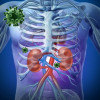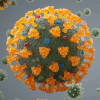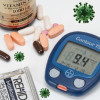
 Dr. KK Aggarwal
Dr. KK Aggarwal
Know the Difference Between Viral Fever and Coronavirus
What’s The Difference?
Influenza (Flu) and COVID-19 are both respiratory diseases that are infectious, although caused by different viruses. COVID-19 is caused by a new coronavirus infection (called SARS-CoV-2) and flu or influenza is caused by influenza virus infections.
There are some key differences between COVID-19 and influenza.
COVID-19 tends to spread more quickly than influenza and in some people causes more severe manifestations. It may take longer for people to develop COVID symptoms and they may remain infectious for more time as well.
Another major distinction is that flu has a preventive vaccine. In order to avoid COVID-19, there is currently no vaccine. Avoiding being exposed to the virus is the best way to prevent infection.
Mentioned below are more details on the differences between influenza and COVID.
Signs & Symptoms
Similarities
There can be varying degrees of signs and symptoms for both COVID-19 and influenza, ranging from no symptoms (asymptomatic) to serious symptoms. Popular symptoms shared by COVID-19 and flu include:
● Fever / chills or feeling feverish
● Coughing
● Shortness of breath or breathing problems
● Fatigue (tiredness)
● Soreness of throat
● Stuffy or runny nose
● Muscle ache and malaise
● Headache
● Some individuals may have vomiting and diarrhoea, but children are more likely to experience this than adults.
Differences
Flu (Viral Fever) COVID-19
● Apart from the common symptoms mentioned above, flu causes mild to serious manifestations.
● Flu usually doesn’t affect your abilities to smell and taste. ● In certain persons, COVID-19 appears to cause more serious illnesses.
● Other signs and symptoms of COVID-19 can include changes in taste or odour, or loss of taste.
Incubation Period
This refers to the time taken for symptoms of the infectious disease to start manifesting after the initial infection.
Similarities
For both COVID-19 and flu, 1 or more days may pass between a person becoming infected and them starting to experience symptoms.
Differences
Flu (Viral Fever) COVID-19
● Shorter. A person typically develops symptoms anywhere between 1 and 4 days after infection. ● Longer. Typically, 5 days after being infected, a person develops symptoms, but symptoms can occur as early as 2 days after infection or as late as 14 days after infection; the time period can differ.
How Long Do You Remain Infectious?
Similarities
It is possible for people infected with both COVID-19 and influenza to transmit the virus for at least 1 day before any symptoms arise.
Differences
Flu (Viral Fever) COVID-19
● Most people with influenza remain infectious for around 1 day before they experience symptoms.
● Older children and adults with influenza tend to be most infectious during their disease 's initial 3-4 days, but many remain infectious for around 7 days.
● Infants and persons with compromised immune systems may be infectious for even longer. ● How long someone can transmit the virus that causes COVID-19 is currently under investigation.
● People will transmit the virus for approximately 2 days until they experience signs or symptoms and remain infectious for at least 10 days after signs or symptoms first appear.
● It is possible to remain infectious for at least 10 days after testing positive for COVID-19 whether anyone is asymptomatic or their symptoms go away.
Mode Of Disease Spread & Infection
Similarities
Both COVID-19 and influenza spreads between people in close contact with each other (within about 6 feet). Both are mainly transmitted by droplets formed when individuals with the disease (COVID-19 or flu) cough, sneeze, or speak. These droplets may land in nearby people's mouths or noses or could be inhaled into the lungs.
Physical human contact (e.g. shaking hands) or touching a surface or object having the virus on it, and then touching one’s own mouth, nose, or possibly eyes, can infect a person.
Before people begin to show symptoms, both the viral types can spread to those with very mild symptoms or the ones who have never developed symptoms (asymptomatic).
Differences
Flu (Viral Fever) COVID-19
● Generally, flu affects younger children more severely.
● Although highly infectious, influenza is said to have had lesser super-spreading events as compared to COVID-19.
● For some populations and age groups, COVID-19 is more infectious than flu.
● COVID-19 has also been shown to have more super-spreading events than influenza, implying that the virus that causes COVID-19 will spread to many individuals quickly and easily and lead to continuous spread among individuals as time progresses.
Complications
Similarities
Complications may result from both COVID-19 and the flu, including:
● Pneumonia
● Respiratory insufficiency
● Acute respiratory distress syndrome (i.e. fluid in the lungs)
● Sepsis
● Heart complications (such as heart attacks and strokes)
● Multi-organ failure (respiratory failure, failure of the kidneys, shock)
● Worsening of chronic medical conditions (including lungs , heart, diabetes or nervous system)
● Heart, brain or muscle tissue inflammation
● Secondary bacterial infections (i.e. infections that occur in people already infected with influenza or COVID-19)
Differences
Flu (Viral Fever) COVID-19
● Most people recover from influenza in a few days, mostly within two weeks, with a very few percentage developing any of the above complications.
● Additional COVID-19 related complications can include:
○ Blood clots in veins and arteries of the lungs, heart, legs or brain
○ Children's Multisystem Inflammatory Syndrome (MIS-C)
The Bottom Line
As we continue to live in these trying times, where the top brains across the world are busy developing vaccines against the coronavirus, it is highly advised to follow the basic guidelines of social distancing, wearing a mask, and practising proper hand hygiene.
If you have fever and malaise accompanied with dry cough and a possible decline in the ability to smell continuously for a week or more, consider getting tested for COVID-19. Look for emergency warning signs for COVID-19. If someone is showing any of these signs, seek emergency medical care immediately:
● Trouble breathing
● Persistent pain or pressure in the chest
● New confusion
● Inability to wake or stay awake
● Bluish lips or face
That said, it is also advised not to get tested unnecessarily. Instead, only consider getting tested if:
1. You have symptoms of COVID-19.
2. You’ve had close contact (within 6 feet of an infected person for a total of 15 minutes or more) with someone with confirmed COVID-19.
3. You’ve been asked or referred to getting tested by your healthcare provider or health department.
There may arise two possibilities upon getting tested. They are:
● If you test positive, know what protective steps to take to prevent others from getting sick.
● If you test negative, you probably were not infected at the time your sample was collected. The test result only means that you did not have COVID-19 at the time of testing. Continue to take steps to protect yourself

Dr. KK Aggarwal
Recipient of Padma Shri, Vishwa Hindi Samman, National Science Communication Award and Dr B C Roy National Award, Dr Aggarwal is a physician, cardiologist, spiritual writer and motivational speaker. He was the Past President of the Indian Medical Association and President of Heart Care Foundation of India. He was also the Editor in Chief of the IJCP Group, Medtalks and eMediNexus




















Please login to comment on this article